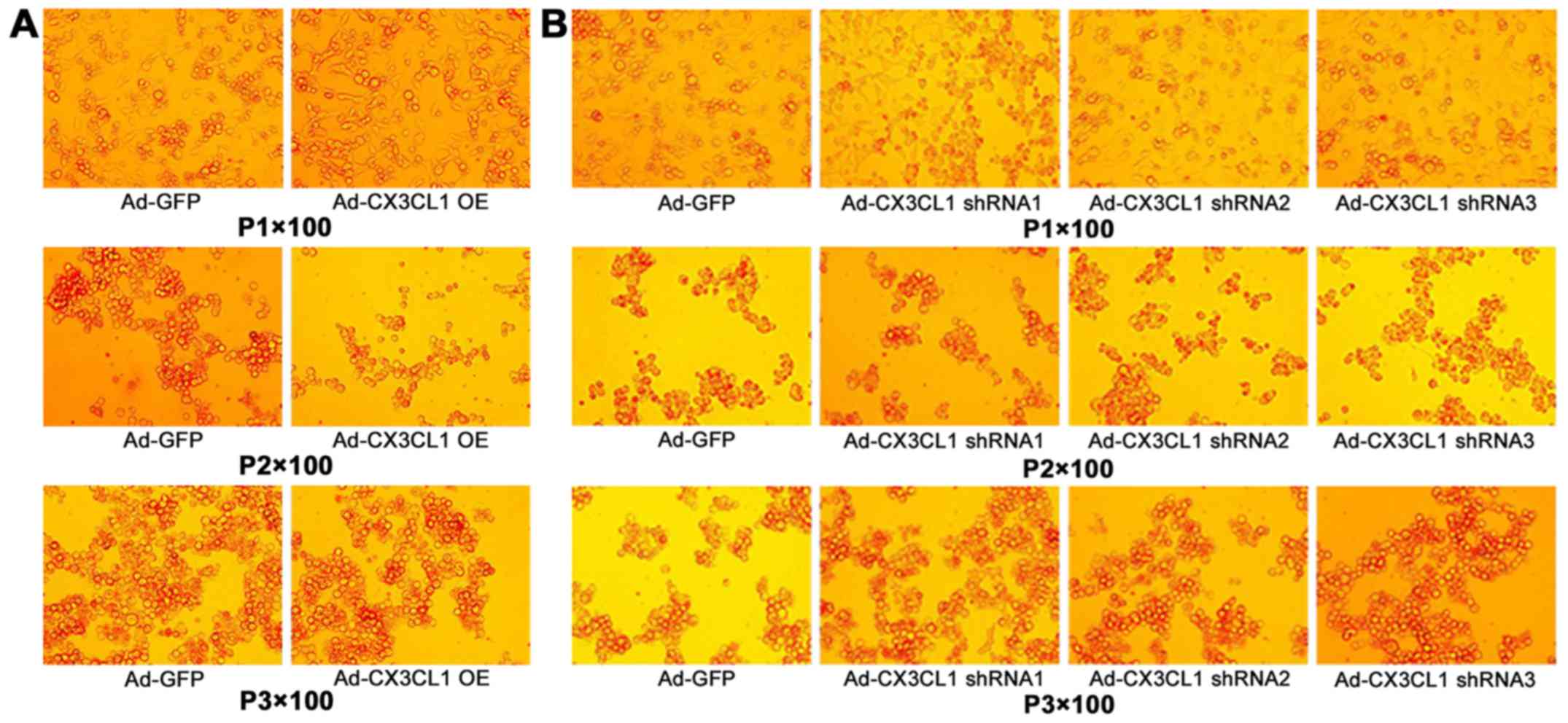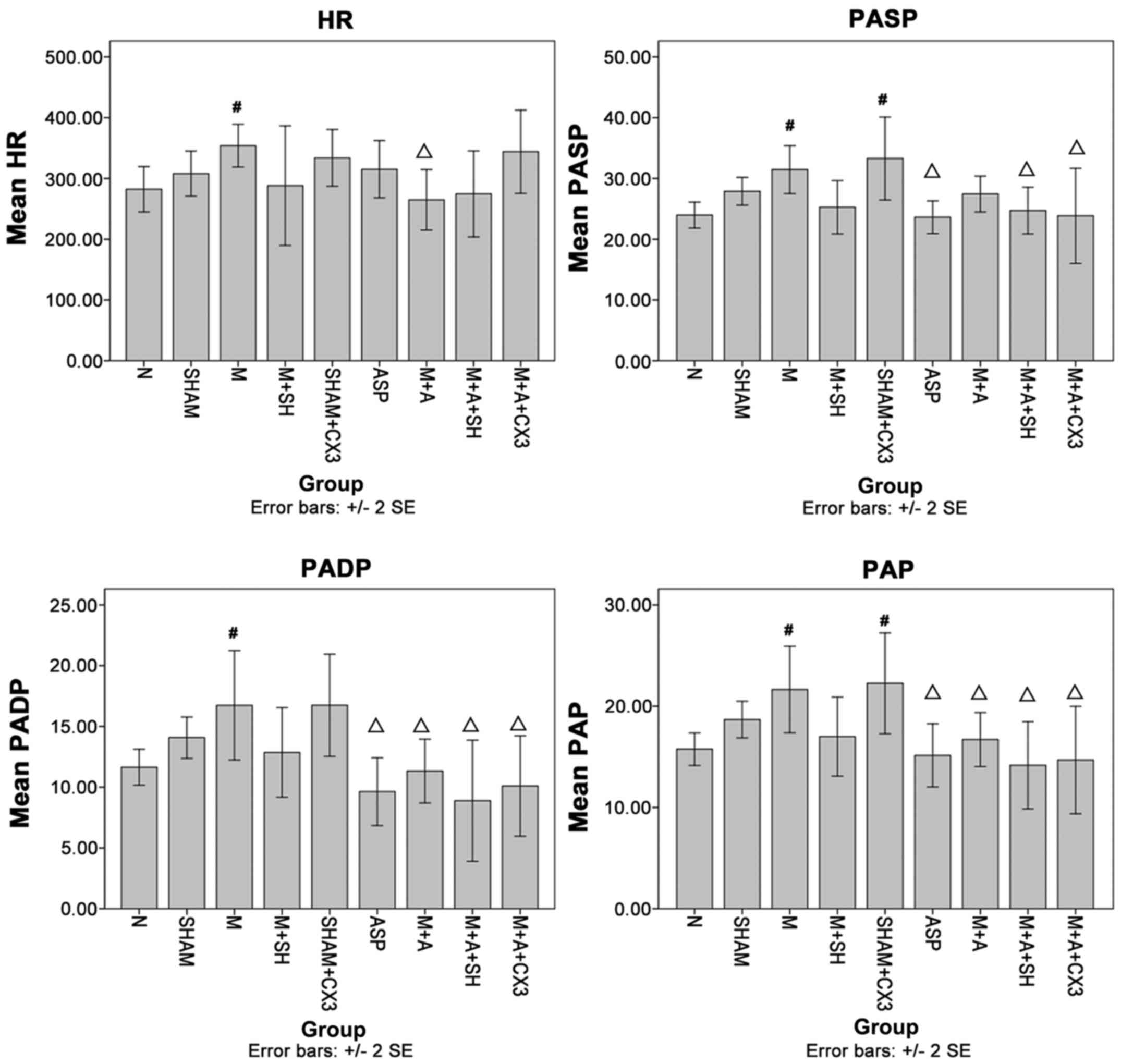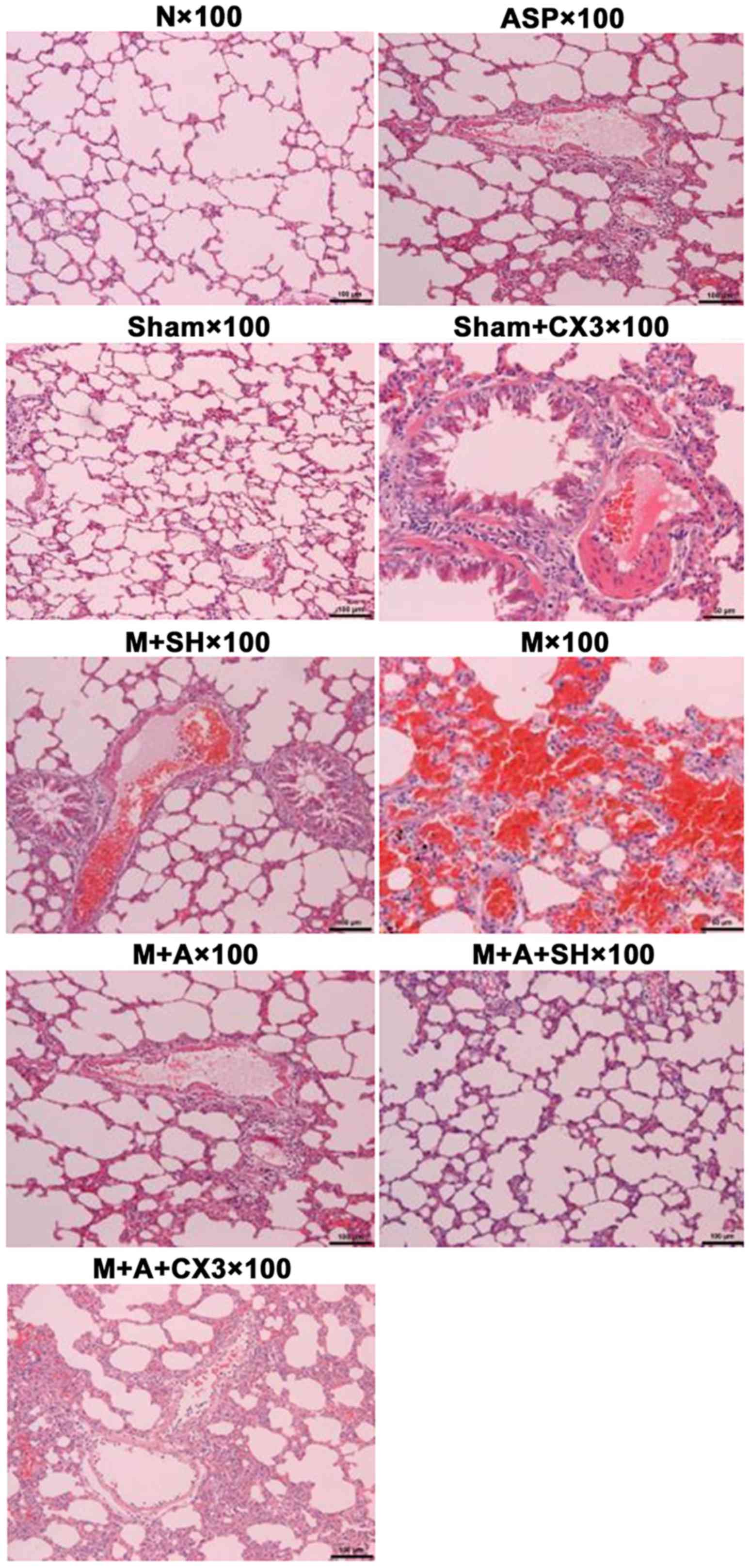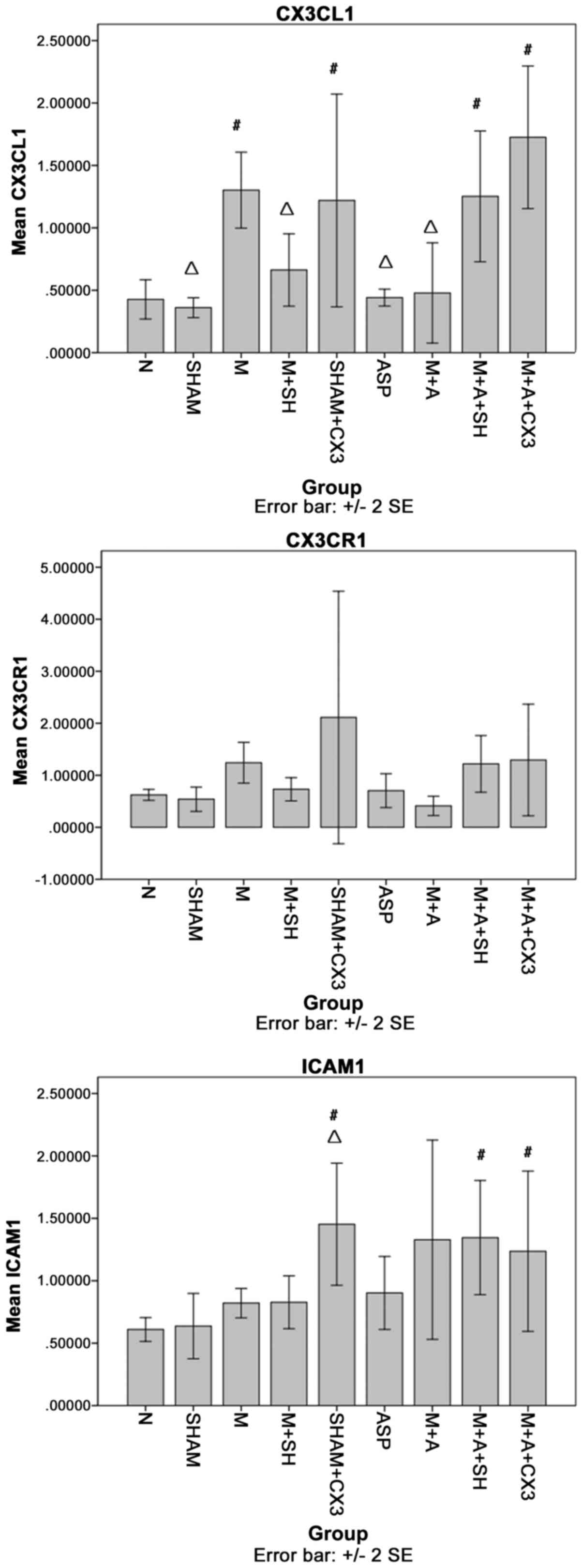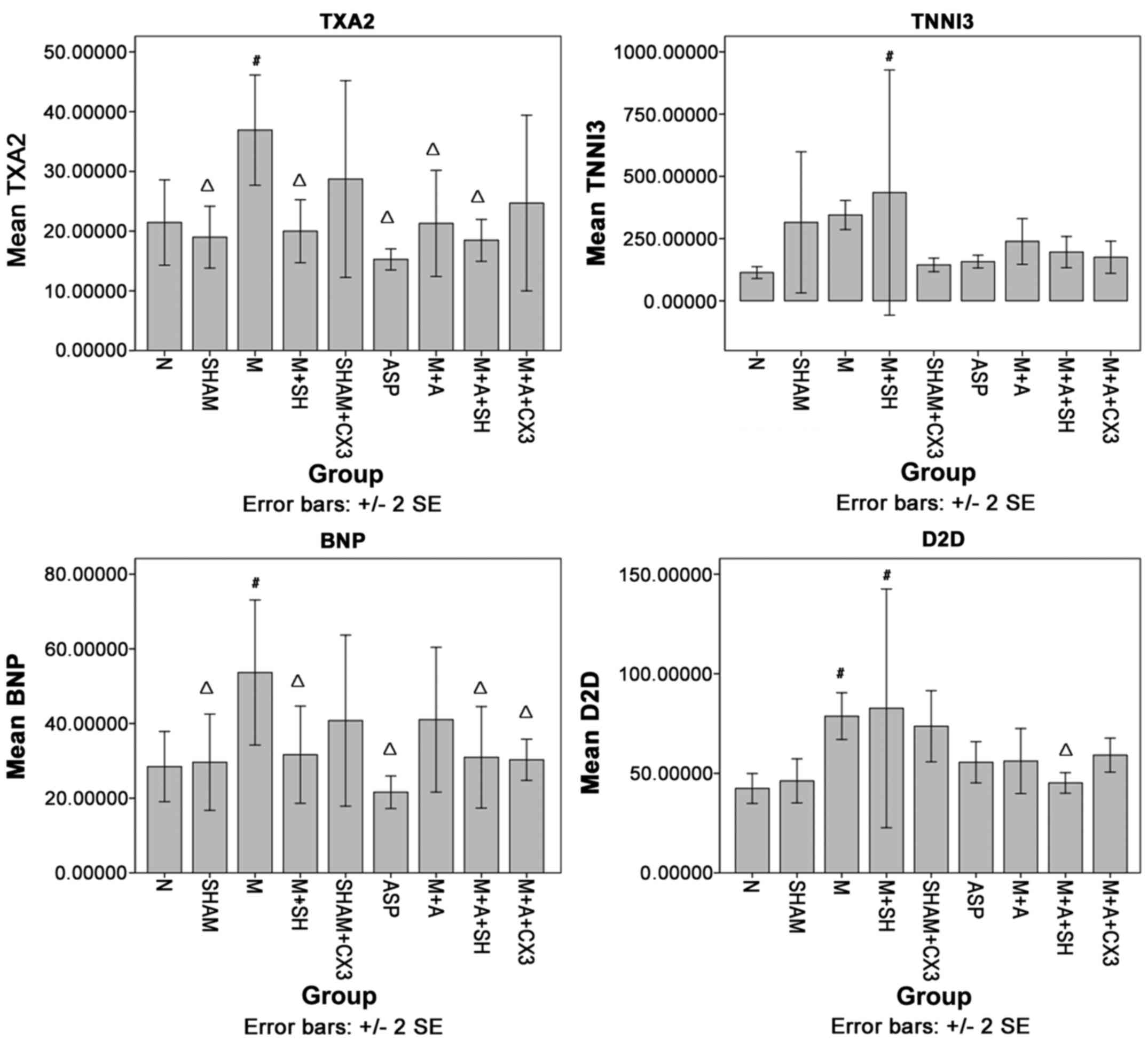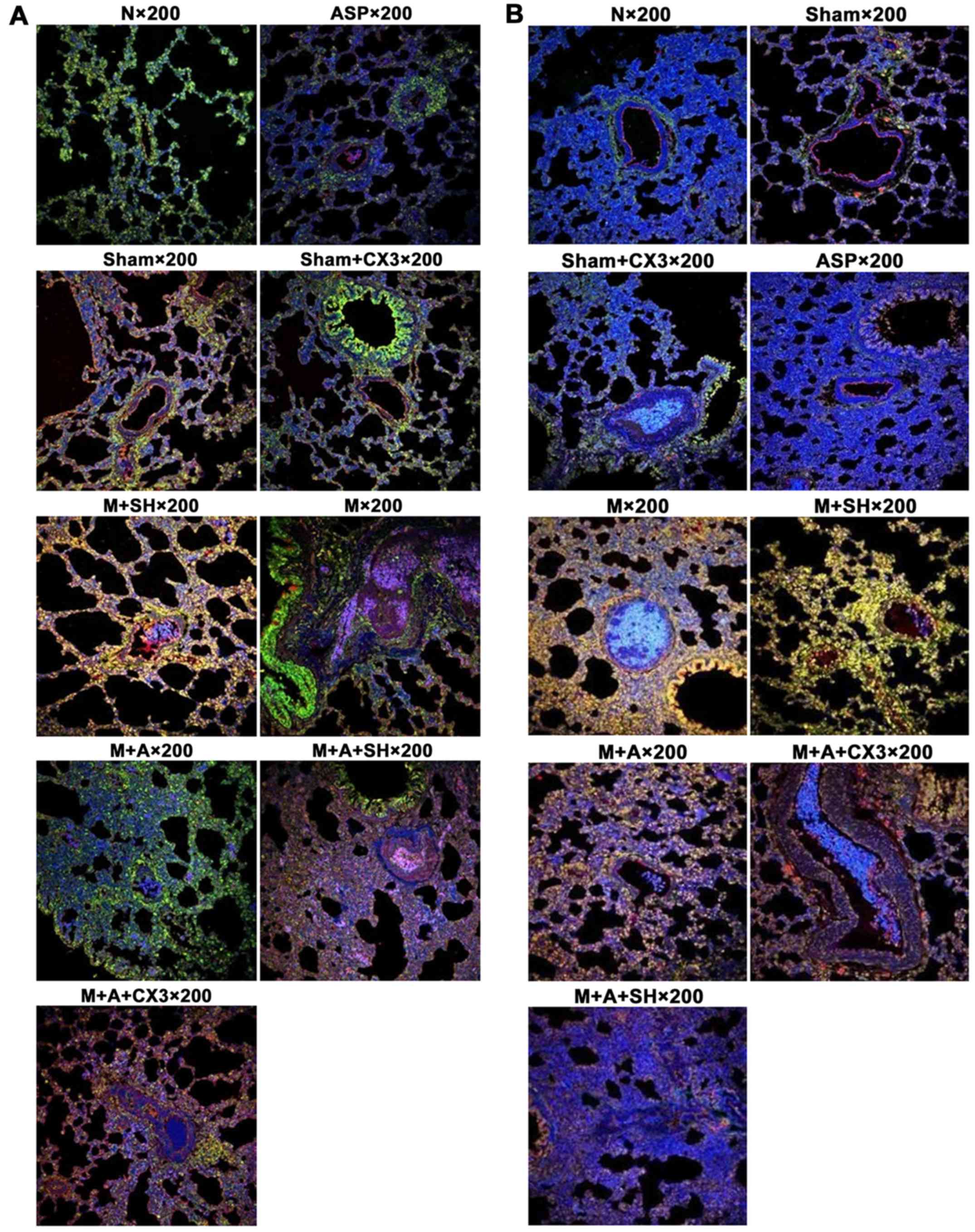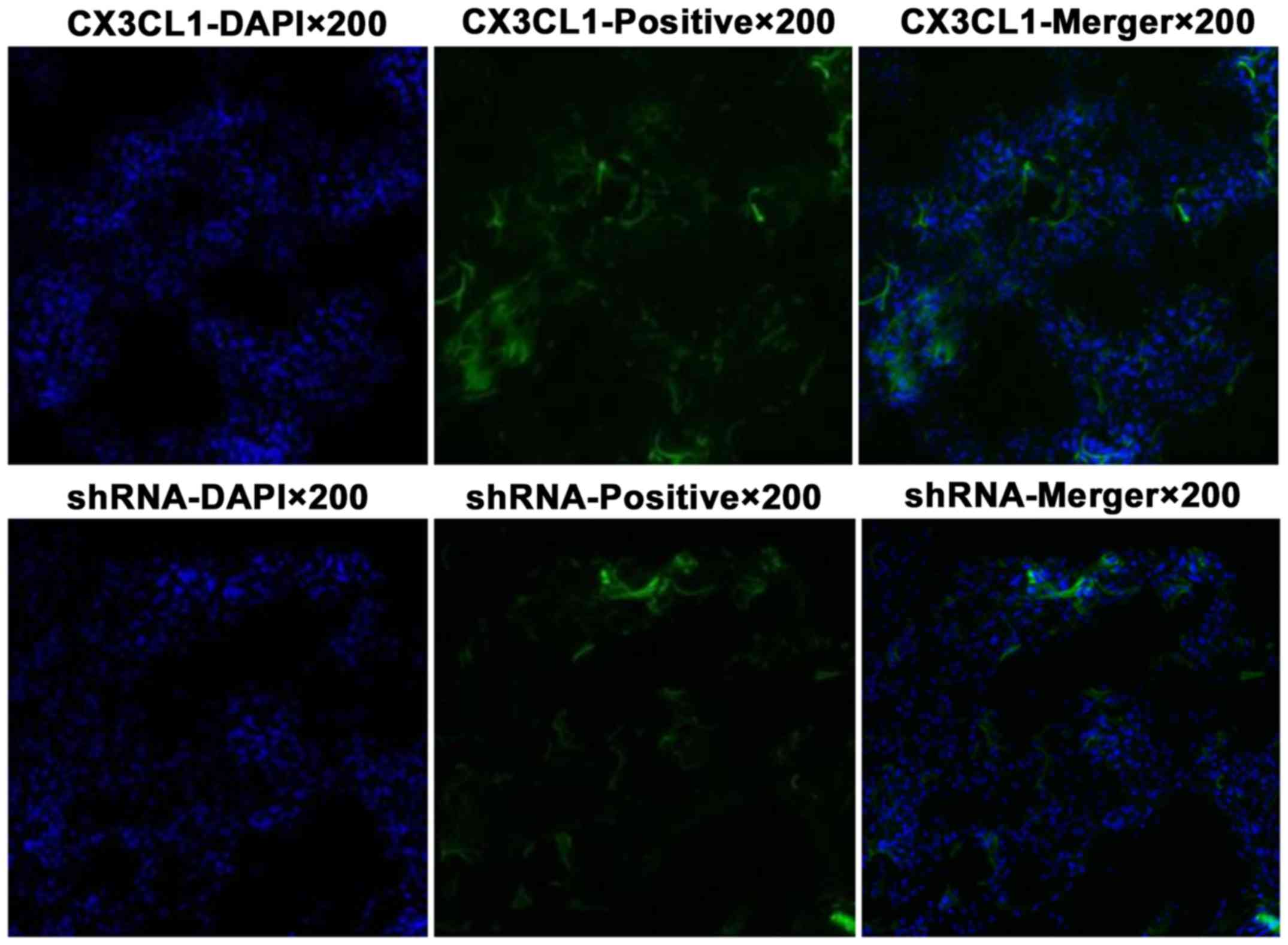Influence of aspirin on the CX3CL1/CX3CR1 signaling pathway in acute pulmonary embolism
- Authors:
- Published online on: April 26, 2017 https://doi.org/10.3892/ijmm.2017.2969
- Pages: 1580-1588
Abstract
Introduction
Acute pulmonary embolism (APE) is a disease caused by various emboli blocking the pulmonary artery, leading to pulmonary circulation disorder. The morbidity and fatality rate are high in European and American countries, and have increased in recent years. The morbidity in the United States during 1979–1999 was reported to be 0.4%, and ~150,000 individuals are hospitalized due to APE every year. There was no obvious change in 20 years (1). The epidemiology of APE is difficult to confirm due to the lack of symptoms and proper diagnosis. In 2004, according to the demographic statistics of 454.4 million people in 6 countries of the European Union, 317,000 deaths related to venous thrombus were reported. Among them, 34% died of acute fat embolism, 59% died of APE (diagnosed by autopsy, not alive), and only 7% were diagnosed with APE prior to death (2). In China, of the 16,972,182 hospitalized patients, 18,206 patients had APE. The annual occurrence rate is 0.1%, and the incidence is significantly higher in males (0.2%) than in females (0.1%). The fatality decreased from 25.1% in 1997 to 8.7% in 2008 (3). APE has become a common cardiovascular disease in China, seriously threatening human health. Thus, interventions are urgently needed.
Previous research found that the levels of tumor necrosis factor-α (TNF-α), interleukin-1β (IL-1β), IL-8, CX3CL1, CX3CR1, nuclear factor-κB (NF-κB), extracellular signal-regulated kinase (ERK), PI3K/Akt, brain natriuretic peptide (BNP), troponin T (TnT) and D-dimer (D2D) were significantly increased in APE rat models (4–6). The increased CX3CL1 level in serum was found to have a positive correlation with serum IL-8 and TNF-α, and aspirin significantly inhibited all the aforementioned factors. Meanwhile, it was also found that aspirin could inhibit lipopolysaccharide and induce the expression of PI3K, Akt, ERK, NF-κB, CX3CL1, matrix metallopeptidase-7 (MMP-7) and MMP-12 in human bronchial epithelial cells (7). Therefore, it is believed that the inflammatory response occurs in APE, CX3CL1/CX3CR1 significantly increases, and TNF-α stimulates CX3CL1, and aspirin can inhibit the aforementioned factors. However, the effect of the CX3CL1/CX3CR1 signaling pathway on the occurrence of APE remains unclear.
In the present study, CX3CL1-short hairpin RNA (shRNA) adenovirus (AD) and CX3CL1-overexpression vector were constructed. Reverse transcription-polymerase chain reaction (RT-PCR), enzyme-linked immunosorbent assay (ELISA), laser confocal scanning microscopy, and pulmonary artery pressure detection were applied to explore the protective effect of aspirin on APE via the CX3CL1/CX3CR1 signaling pathway in an animal model.
Materials and methods
Materials
Enteric-coated aspirin tablets were procured from Nanjing Baijingyu Pharmaceutical Co., Ltd. (Jiangsu, China; drug specifications: 25 mg × 100 pills/bottle, batch no. 141201).
Male Sprague-Dawley (SD) rats (200 g) were purchased from Shanghai SLAC Laboratory Animal Co., Ltd. (Shanghai, China) and Vital River Laboratories Co., Ltd. (Beijing, China). The feeding temperature was 20–25°C, and the humidity was 40–70%. After a 6-day acclimation, the experiment was intiated. The study was approved by the Ethics Committee of Zhejiang Chinese Medical University.
Construction of the CX3CL1-overexpression vector and shRNA was performed. Vector pHBAd-murine cytomegalo-virus (MCMV)-green fluorescent protein (GFP) and vector pHBAd-U6-GFP (Hanbio, Hangzhou, China) were used. Escherichia coli strain DH5α (Tiangen, Beijing, China), restriction enzymes, T4 ligase (both from Fermentas, Waltham, MA, USA), and plasmid DNA extraction kit (CWBio, Beijing, China) were used.
Biological function experimental system (BL-420S) and animal ventilator (HX-300) were obtained from Taimeng (Sichuan, China). Multiskan spectrum microplate spectrophotometer (Spectra Plus 384) was purchased from Molecular Devices (Sunnyvale, CA, USA).
Hematoxylin and eosin staining (H&E) was used to observe histopathological changes in the pulmonary tissue.
Thromboxane A2 (TXA2), troponin I type 3 (TNNI3), BNP and D2D levels in rat serum were detected using ELISA. TTNNI3kit, BNP, TXA2 and D2D were obtained from Youershengke (Wuhan, China).
RT-PCR was used to detect CX3CL1, CX3CR1 and intercellular adhesion molecule-1 (ICAM-1) expression in mRNA of rat pulmonary tissue. A high-purity total RNA rapid extraction kit was obtained from Generay (Shanghai, China), and a PrimeScript RT reagent kit was purchased from Takara (Tokyo, Japan). Super Real PreMix Plus (with SYBR-Green I) was obtained from Tiangen. High-precision spectrophotometer (Merinton SMA4000; Merinton Instrument, Ltd., Beijing, China) and quantitative PCR system (CFX connect real-time PCR system; Bio-Rad, Hercules, CA, USA) were used.
Laser confocal scanning microscopy was used to detect the coexpression of CX3CL1/CX3CR1 and CX3CL1/NF-κB. Fractalkine antibody (CX3CL1) (cat. no. sc-7227; batch no. B1612; 1:10; Santa Cruz Biotechnology, Inc., Santa Cruz, CA, USA), anti-NF-κB p65 antibody (cat. no. ab7970; batch no. GR187946-6; 1:50), anti-CX3CR1 antibody (cat. no. ab8021; batch no. GR90085-11; 1:100) (both from Abcam, Cambridge, MA, USA), anti-rabbit IgG secondary antibody (cat. no. A21206; batch no. 1110071; 488 conjugate; Life Technologies, Carlsbad, CA, USA; excitation wavelength/emission wavelength: 488/520 nm, 1:200), anti-goat IgG secondary antibody (cat. no. A21432; batch no. 1620248; 555 conjugate; excitation wavelength/emission wavelength: 555/562 nm, 1:200) (Life Technologies), 4′,6-diamidino-2-phe-nylindole (DAPI) (excitation wavelength/emission wavelength: 358/461 nm; Sigma, St. Louis, MO, USA) were used.
Methods
Preparation of the CX3CL1-overexpression vector and shRNA
The steps for construction of CX3CL1 overexpression AD are as follows. AD vector plasmid was recombined and pHBAd-MCMV-GFP vector was digested with EcoRI and BamHI double enzymes and collected after digestion. CX3CL1 fragments were obtained, and the transformed CX3CL1 was used to select bacterial colonies. The bacteria were incubated by shaking for 14 h at 37°C and 250 rpm. The bacterial suspension was detected using PCR and sequenced to obtain pHBAd-MCMV-GFP-CX3CL1 recombinant vector, marked as AD-CX3CL1. Meanwhile, plasmid pHBAd-MCMV-GFP was used as the control, and marked as AD-GFP. Recombinant plasmids and recombinant AD vector package were prepared. Then, virus harvesting, amplification, purification, and detection of the infectious titer were performed. CX3CL1 shRNA AD construction process was as follows. pHBAd-U6-GFP interference vector was used, and the interference sequence was designed to construct, screen and identify CX3CL1 shRNA (Fig. 1).
Animal model
Male SD rats (200±20 g) were randomly divided into 9 groups (n=10): normal group (group N), sham operation group (group Sham), sham operation + aspirin group (group ASP), model group (group M), model + ASP group (group M+A), model + shRNA (group M+SH), sham operation + CX3CL1-overexpression vector group (group Sham+CX3), model + ASP + shRNA group (group M+A+SH), and model + ASP + CX3CL1-overexpression vector group (group M+A+CX3). Autologous thrombus was injected through the jugular vein to copy a rat PTE model. One day before surgery, 0.2 ml of blood was withdrawn from the caudal vein, and incubated at 37°C overnight. The concretionary thrombus was taken out to prepare 30 emboli (2×1 mm2), which were further placed into a 2-ml syringe. The rats were anesthetized using 10% chloral hydrate (0.3 g/kg). The right jugular vein was separated, and the puncture needle was placed. The prepared embolus was pushed into the common vein using the puncture needle, followed by pushing 1 ml of saline to prevent the embolus from staying in the tube or jugular vein. Finally, the wound was sutured after the bleeding stopped. One day before surgery and 40 min before modeling, the drug was administrated via gavage. The virus intervention groups (group M+SH, group Sham+CX3, group M+A+SH, group M+A+CX3) were injected once with aspirin 300 mg/kg through the caudal vein 3 days before modeling (109 pfu/rat). Group Sham and group M received an equal volume of saline every day. Group N did not receive any intervention.
Detection of pulmonary artery pressure
Six hours after modeling, the animals were anesthetized again. A PE50 tube was inserted into the pulmonary artery, and the other side was connected with a pressure transducer. A waveform of pulmonary artery pressure was recorded using the biological function experimental system (BL-420S), and pulmonary arterial systolic pressure (PASP), pulmonary artery diastolic pressure (PADP) and pulmonary arterial pressure (PAP) were calculated.
Pulmonary pathology was detected using H&E staining and CX3CL1, CX3CR1 and ICAM-1 in pulmonary tissue were detected by RT-PCR.
TXA2, BNP, TNNI3 and D-dimer in serum were detected by double-antibody sandwich or competitive inhibition ELISA.
CX3CL1/CX3CR1 coexpression and CX3CL1/NF-κB coexpression in the pulmonary tissue were detected by laser confocal scanning microscopy.
The virus intervention group was divided into two subgroups (CX3CL1-overexpression group and shRNA group). The tissue was cut into 8-µm slices at −20°C and observed by a fluorescence microscope.
Statistical analysis
SPSS 21.0 (SPSS, Chicago, IL, USA) was used for data analysis, and the results are expressed as mean ± standard deviation. One-way analysis of variance was used, and pairwise comparison between groups was analyzed by least significant difference. A P-value <0.0 was considered to indicate a statistically significant result.
Results
Detection of pulmonary artery pressure
Compared with group N, hear rate (HR), PASP, PADP and PAP in group M were significantly increased (P<0.05). PASP and PAP in group Sham+CX3 were significantly increased (P<0.05). Compared with group M, HR in group M+A was significantly decreased (P<0.05), PASP in groups M+A+SH, ASP and M+A+CX3 were also significantly decreased (P<0.05). PADP and PAP in groups ASP, M+A, M+A+SH, and M+A+CX3 were significantly decreased (P<0.05) (Fig. 2).
Pulmonary H&E detection
The results of lung pathology as detected by H&E are shown in Table I and Fig. 3.
CX3CL1, CX3CR1 and ICAM-1 in the pulmonary tissue as detected by PCR
As shown in Fig. 4, compared with group N, CX3CL1 in groups M, Sham+CX3, M+A+SH and M+A+CX3 was significantly increased (P<0.05). Compared with group M, CX3CL1 in groups N, Sham, M+SH, ASP and M+A was significantly decreased (P<0.05).
The comparisons of CX3CR1 among the different groups showed no significant differences.
Compared with group N, ICAM-1 in groups Sham+CX3, M+A+SH and M+A+CX3 was significantly increased (P<0.05). Compared with group M, ICAM-1 in group Sham+CX3 was significantly decreased (P<0.05).
TXA2, TNNI3, BNP and D2D levels in rat serum as detected by ELISA
As shown in Fig. 5, compared with group N, TXA2 in group M was significantly increased (P<0.05). Compared with group M, TXA2 in groups N, Sham, M+SH, ASP, M+A and M+A+SH was significantly decreased (P<0.05).
Compared with group N, TNNI3 in group M+SH was significantly increased (P<0.05). Compared with group M, no significant difference was observed.
Compared with group N, BNP in group M was significantly increased (P<0.05). Compared with group M, BNP in groups N, Sham, M+SH, ASP, M+A+SH and M+A+CX3 was significantly decreased (P<0.05).
Compared with group N, D2D in groups M and M+SH was significantly increased (P<0.05). Compared with group M, D2D in groups N and M+A+SH was significantly decreased (P<0.05).
Coexpression of CX3CL1/CX3CR1 and CX3CL1/NF-κB as detected by laser confocal scanning microscopy
The positive color of immunofluorescence indicated that CX3CL1 (red) and CX3CR1 (green) were mainly expressed in the cytoplasm and cytomembrane. NF-κB (green) was mainly expressed in the cytoplasm, and rarely expressed in the cell nucleus. As shown in Tables II and III and Fig. 6, the fluorescence strength of each group was compared according to the following standard: slight, +; moderate, ++; strong, +++.
Virus infection of the rat pulmonary tissue as observed by laser confocal scanning microscopy
The pulmonary tissue infected by the virus is shown in green color, and the cell nucleus is shown in blue color (Fig. 7).
Discussion
In the present study, CX3CL1-shRNA AD and CX3CL1-overexpression vector were constructed. The study aimed to investigate the influence of CX3CL1 on APE. Compared with a previous study, this study detected pulmonary artery pressure. Although the pressure was not as visual as CTPA, it still could reflect the pressure change after APE. To directly observe the correlation between CX3CL1 in the APE site and CX3CR1 expression and the correlation between the change in the CX3CL1/CX3CR1 signaling pathway and NF-κB inflammatory pathway, laser confocal scanning microscopy was used. Due to the use of many groups, the experiment was divided into three steps: i) group N, group Sham, group M and group M+A; ii) group M, group M+SH and group M+CX3; iii) group M+SH, group M+CX3, group M+A+SH and group M+A+SH. The first step focused on the drug effect and change in the signaling pathway, the second confirmed the influence of the change in the inflammatory pathway on APE (especially the change in proteins of the signaling pathway), and the third investigated the relationship between the signaling pathway and aspirin (especially the change in the signaling pathway). It was found that aspirin significantly decreased the pulmonary artery pressure, improved pathological changes in the embolism, and decreased the expression of the CX3CL1/CX3CR1 and CX3CL1/NF-κB signaling pathways. Moreover, the AD overexpression CX3CL1 vector aggravated the inflammatory changes in rats with APE, which were improved by aspirin. However, AD CX3CL1 intervention decreased this change, and its combination with aspirin significantly improved the APE changes.
The presemt study explored the important role of the CX3CL1/CX3CR1 signaling pathway in the occurrence of APE as well as improvement in APE changes by aspirin via the signaling pathway. Therefore, pulmonary artery pressure, pulmonary H&E and ELISA were used to quantitatively detect TNNI3, BNP and D2D levels in rat serum. The limitation of the study was that APE was mainly a mechanical obstruction of the pulmonary artery; neurohumoral (inflammatory mediator) control was not the key factor, and hence should not be emphasized, or a disconnection between experimental findings and clinical practice would result.
If therapy for APE is effective, it should significantly decrease the pulmonary artery pressure. When APE occurs, pulmonary artery pressure is increased. The present study found that HR, PASP, PADP and PAP in group M were significantly increased. Therefore, it was believed that the APE model was successful from the aspect of hemodynamics. The HR in group M+A was significantly decreased compared with group M, suggesting that aspirin took effect on APE. The pulmonary artery pressures in group M+A+SH and group M+A+CX3 was significantly decreased, indicating no overexpression or inhibition of CX3CL1; aspirin decreased the pulmonary artery pressure. It was confirmed by pulmonary H&E detection that only APE was affected by aspirin. Irrespective of the expression or inhibition of CX3CL1, the degree of APE and inflammation was less. The prognosis of APE is related to TnT, BNP and D2D (8). Therefore, these three indicators were used in the present study. After successful APE modeling, serum BNP and D2D were significantly increased. Furthermore, BNP was significantly decreased in M+SH, M+A+SH and M+A+CX3, and D2D was significantly decreased in M+A+SH, suggesting that the inhibition of CX3CL1 could improve the pathology of APE.
The European Society of Cardiology reported that APE is the most severe clinical manifestation of venous thromboembolism (VTE) (8). The basic process of APE includes mechanical obstruction. Pulmonary artery spasm contraction caused by neurohumoral factor (mainly inflammatory mediator) also plays an important role, especially within a short time. It mainly involves fibrous proteins and aggregated blood platelets, and also infiltration of various inflammatory cells. They continuously release a series of inflammatory mediators such as A2 (TXA2) (9) to shrink the pulmonary artery. More attention has been paid to the first step, and less to the second step.
CX3CL1 (fractalkine) is a chemotactic factor containing 373 amino acids. It possesses adhesive and chemotactic activity. It is the only member of the CX3C family (10), and can combine with a specific receptor CXCCR1, mediating the intimate adhesion of inflammatory cells and vascular endothelium cells. CX3CL1 plays an important role in the recruitment of inflammatory cells on the vascular wall and injury of endothelial cells (11,12). It was reported that TNF-α could influence the CX3CL1/CX3CR1 inflammatory signaling pathway (13), which was confirmed in a previous study (5). It was also demonstrated that the CX3CL1/CX3CR1 signaling pathway exists in atherosclerosis (14), and CX3CL1 plays a role in high pulmonary artery pressure combined with high airway pressure (15). However, still no systematic study exists on the mechanism underlying the involvement of CX3CL1/CX3CR1 in APE.
It was also confirmed that CX3CL1 was significantly increased in APE. Aspirin could inhibit the expression, as shown in this study. CX3CL1 in group Sham+CX3 was significantly increased and that in group M+SH was significantly decreased, suggesting that the preparations of CX3CL1 AD and shRNA AD were successful.
ICAM-1 is a member of the immunoglobulin super-family (16). It is mainly expressed in neuronal cells, immune cells, vascular endothelium cells, epithelial cells, and glial cells. It is one of the important leukocyte-endothelial cell adhesion molecules, and is involved in intracellular and cell-matrix signal exchange, mediating adhesion, recognition, activation, proliferation, differentiation, inflammatory reaction and damage repair. After CX3CL1 overexpression in group Sham, the ICAM-A level was significantly higher than that in group N and group M, indirectly suggesting that CX3CL1 could stimulate the secretion of ICAM-1.
The TXA2 level in rats with APE was significantly increased, and the levels in groups M+SH, M+A and M+A+SH were significantly decreased. This indicated that aspirin could decrease TXA2 secretion after inhibiting CX3CL1 expression.
The coexpression of CX3CL1/CX3CR1 and CX3CL1/NF-κB as detected by double immunofluorescent staining suggested increased expression of the aforementioned factors.
Therapy for APE includes streptokinase, urokinase, recombinant tissue plasminogen activator thrombolysis, low-molecular-weight heparin and new oral anticoagulants (1,8,17). The selection of aspirin was due to the inflammatory response after the occurrence of APE. It could irreversibly inhibit epoxidase and further inhibit the formation of thromboxane A2 in blood platelets. It could also inhibit the activation of NF-κB and exert anti-inflammatory effects. As nonsteroidal anti-inflammatory drugs are not specific, their high concentration may effectively inhibit inflammatory factors such as NF-κB (18,19). A previous study found that aspirin could inhibit NF-κB expression in APE (5). Aspirin inhibits CX3CL1/CX3CR1 expression (20,21). It can be safely applied in APE or for preventing deep vein thrombosis (22,23). The daily aspirin dose was reported to be 325 mg for 14 days. Prevention and treatment of VTE was safe, thus the dose of aspirin was increased in the present study (24). This study demonstrated that aspirin improved the pathological changes in rats with APE via the CX3CL1/CX3CR1 signaling pathway.
Future studies should investigate the effect (and its underlying mechanism) of CX3CL1 on thrombogenesis by influencing the damage of vascular endothelium cells and inflammatory response.
Acknowledgments
The present study was funded by the Medical and Health Platform Program of Zhejiang Province (key support) (grant no. 2015ZDA022), Zhejiang Provincial Program for the Cultivation of High-Level Innovative Health Talents (2014-108) and the Natural Sciences Fund of Zhejiang Province (grant nos. LY17H290006 and LY12H29005).
Glossary
Abbreviations
Abbreviations:
|
APE |
acute pulmonary embolism |
|
HR |
heart rate |
|
TNF-α |
tumor necrosis factor-α |
|
IL |
interleukin |
|
NF |
nuclear factor |
|
ERK |
extracellular signal-regulated kinase |
|
BNP |
brain natriuretic peptide |
|
TnT |
troponin T |
|
MMP |
matrix metallopeptidase |
|
shRNA |
short hairpin RNA |
|
RT-PCR |
reverse transcription-polymerase chain reaction |
|
ELISA |
enzyme-linked immunosorbent assay |
|
SD |
Sprague-Dawley |
|
MCMV |
murine cytomegalovirus |
|
GFP |
green fluorescent protein |
|
H&E |
hematoxylin and eosin staining |
|
TXA2 |
thromboxane A2 |
|
TNNI3 |
troponin I type 3 |
|
D2D |
D-dimer |
|
ICAM |
intercellular adhesion molecule |
|
AD |
adenovirus |
|
PASP |
pulmonary arterial systolic pressure |
|
PADP |
pulmonary artery diastolic pressure |
|
PAP |
pulmonary arterial pressure |
|
VTE |
venous thromboembolism |
References
|
Geerts WH, Bergqvist D, Pineo GF, Heit JA, Samama CM, Lassen MR and Colwell CW: Prevention of venous thromboembolism: American college of chest physicians evidence-based clinical practice guidelines (8th edition). Chest. 133(Suppl 6): 381S–453S. 2008. View Article : Google Scholar : PubMed/NCBI | |
|
Cohen AT, Agnelli G, Anderson FA, Arcelus JI, Bergqvist D, Brecht JG, Greer IA, Heit JA, Hutchinson JL, Kakkar AK, et al VTE Impact Assessment Group in Europe (VITAE): Venous thromboembolism (VTE) in Europe: The number of VTE events and associated morbidity and mortality. Thromb Haemost. 98:756–764. 2007.PubMed/NCBI | |
|
Yang Y, Liang L, Zhai Z, He H, Xie W, Peng X and Wang C; Investigators for National Cooperative Project for Prevention and Treatment of PTE-DVT: Pulmonary embolism incidence and fatality trends in chinese hospitals from 1997 to 2008: A multicenter registration study. PLoS One. 6:e268612011. View Article : Google Scholar : PubMed/NCBI | |
|
Wang L, Wu J, Zhang W, Zhi Y, Wu Y, Jiang R and Yang R: Effects of aspirin on the ERK and PI3K/Akt signaling pathways in rats with acute pulmonary embolism. Mol Med Rep. 8:1465–1471. 2013.PubMed/NCBI | |
|
Wang LC, Jiang RL, Zhang W, Wei LL and Yang RH: Effects of aspirin on the expression of nuclear factor-κB in a rat model of acute pulmonary embolism. World J Emerg Med. 5:229–233. 2014. View Article : Google Scholar | |
|
Wang LC, Wu JN, Xia GL, Mao W, Ying RB, Huang LQ and Jiang RL: Effect of aspirin on fractalkine in rats with pulmonary embolism. Trop J Pharm Res. 13:753–760. 2014. View Article : Google Scholar | |
|
Jiang R, Wei L, Zhu M, Wu J and Wang L: Aspirin inhibits LPS-induced expression of PI3K/Akt, ERK, NF-κB, CX3CL1, and MMPs in human bronchial epithelial cells. Inflammation. 39:643–650. 2016. View Article : Google Scholar | |
|
Konstantinides S, Torbicki A, Agnelli G, Danchin N, Fitzmaurice D, Galiè N, Gibbs J, Huisman M, Humbert M, Kucher N, et al; SEC Working Group for the ESC 2014 Guidelines on the Diagnosis and Management of Acute Pulmonary Embolism; Expert Reviewers for the ESC 2014 Guidelines on the Diagnosis and Management of Acute Pulmonary Embolism. SEC Clinical Practice Guidelines Committee: Comments on the 2014 ESC Guidelines on the diagnosis and management of acute pulmonary embolism. Rev Esp Cardiol (Engl Ed). 68:10–16. 2015. | |
|
Schmeck J, Koch T, Patt B, Heller A, Neuhof H and van Ackern K: The role of endothelin-1 as a mediator of the pressure response after air embolism in blood perfused lungs. Intensive Care Med. 24:605–611. 1998. View Article : Google Scholar : PubMed/NCBI | |
|
Bazan JF, Bacon KB, Hardiman G, Wang W, Soo K, Rossi D, Greaves DR, Zlotnik A and Schall TJ: A new class of membrane-bound chemokine with a CX3C motif. Nature. 385:640–644. 1997. View Article : Google Scholar : PubMed/NCBI | |
|
Todorova D, Sabatier F, Doria E, Lyonnet L, Vacher Coponat H, Robert S, Despoix N, Legris T, Moal V, Loundou A, et al: Fractalkine expression induces endothelial progenitor cell lysis by natural killer cells. PLoS One. 6:e266632011. View Article : Google Scholar : PubMed/NCBI | |
|
Matsumiya T, Ota K, Imaizumi T, Yoshida H, Kimura H and Satoh K: Characterization of synergistic induction of CX3CL1/fractalkine by TNF-alpha and IFN-gamma in vascular endothelial cells: An essential role for TNF-alpha in post-transcriptional regulation of CX3CL1. J Immunol. 184:4205–4214. 2010. View Article : Google Scholar : PubMed/NCBI | |
|
Szukiewicz D, Kochanowski J, Mittal TK, Pyzlak M, Szewczyk G and Cendrowski K: CX3CL1 (fractalkine) and TNFα production by perfused human placental lobules under normoxic and hypoxic conditions in vitro: The importance of CX3CR1 signaling. Inflamm Res. 63:179–189. 2014. View Article : Google Scholar | |
|
Apostolakis S and Spandidos D: Chemokines and atherosclerosis: Focus on the CX3CL1/CX3CR1 pathway. Acta Pharmacol Sin. 34:1251–1256. 2013. View Article : Google Scholar : PubMed/NCBI | |
|
Ars C, Thurion P, Delos M, Sibille Y and Pilette C: Small airway obstruction in severe pulmonary arterial hypertension correlates with increased airway CD8+ T-cells and fractalkine expression. Eur Respir J. 34:1494–1496. 2009. View Article : Google Scholar : PubMed/NCBI | |
|
Ostrowski RP, Jadhav V, Chen W and Zhang JH: Reduced matrix metalloproteinase-9 activity and cell death after global ischemia in the brain preconditioned with hyperbaric oxygen. Acta Neurochir Suppl (Wien). 106:47–49. 2010. View Article : Google Scholar | |
|
Wang C, Zhai Z, Yang Y, Cheng Z, Ying K, Liang L, Dai H, Huang K, Lu W, et al: Inverse relationship of bleeding risk with clot burden during pulmonary embolism treatment with LMW heparin. Clin Respir J. 10:596–605. 2016. View Article : Google Scholar | |
|
Bhattacharyya S, Ghosh S and Sil PC: Amelioration of aspirin induced oxidative impairment and apoptotic cell death by a novel antioxidant protein molecule isolated from the herb Phyllanthus niruri. PLoS One. 9:e890262014. View Article : Google Scholar : PubMed/NCBI | |
|
Yamamoto Y and Gaynor RB: Therapeutic potential of inhibition of the NF-kappaB pathway in the treatment of inflammation and cancer. J Clin Invest. 107:135–142. 2001. View Article : Google Scholar : PubMed/NCBI | |
|
Szukiewicz D, Wojciechowska M, Bilska A, Stangret A, Szewczyk G, Mittal TK, Watroba M and Kochanowski J: Aspirin action in endothelial cells: Different patterns of response between chemokine CX3CL1/CX3CR1 and TNF-α/TNFR1 signaling pathways. Cardiovasc Drugs Ther. 29:219–229. 2015. View Article : Google Scholar : PubMed/NCBI | |
|
Guo Y, Apostalakis S, Blann AD and Lip GY: Plasma CX3CL1 levels and long term outcomes of patients with atrial fibrillation: The West Birmingham Atrial Fibrillation Project. Cerebrovasc Dis. 38:204–211. 2014. View Article : Google Scholar : PubMed/NCBI | |
|
Ogonda L, Hill J, Doran E, Dennison J, Stevenson M and Beverland D: Aspirin for thromboprophylaxis after primary lower limb arthroplasty: Early thromboembolic events and 90 day mortality in 11,459 patients. Bone Joint J. 98-B:341–348. 2016. View Article : Google Scholar : PubMed/NCBI | |
|
Braithwaite I, Dunbar L, Eathorne A, Weatherall M and Beasley R: Venous thromboembolism rates in patients with lower limb immobilization after Achilles tendon injury are unchanged after the introduction of prophylactic aspirin: Audit. J Thromb Haemost. 14:331–335. 2016. View Article : Google Scholar | |
|
Kaye ID, Patel DN, Strauss EJ, Alaia MJ, Garofolo G, Martinez A and Jazrawi LM: Prevention of venous thromboembolism after arthroscopic knee surgery in a low-risk population with the use of aspirin. A randomized trial. Bull Hosp Jt Dis (2013). 73:243–248. 2015. |



